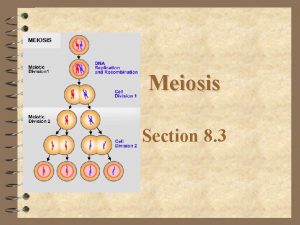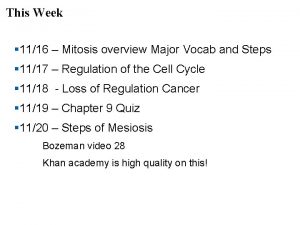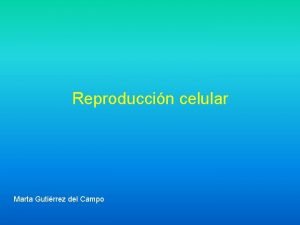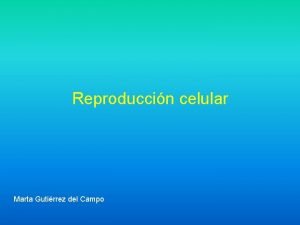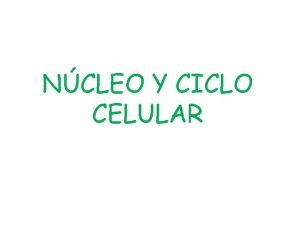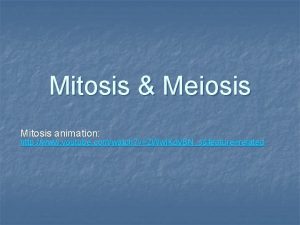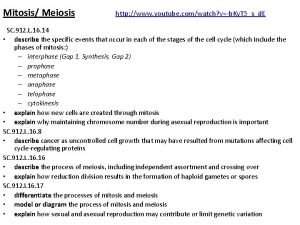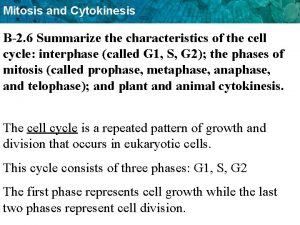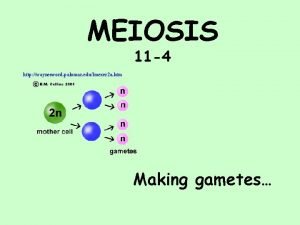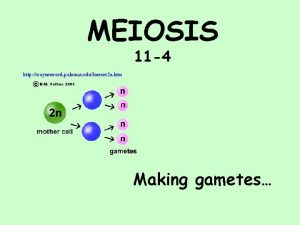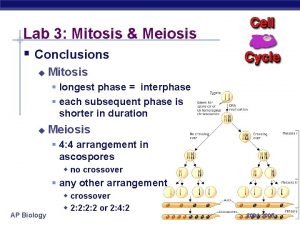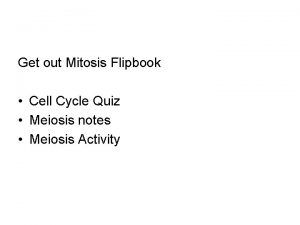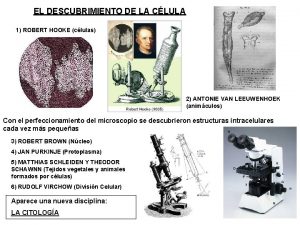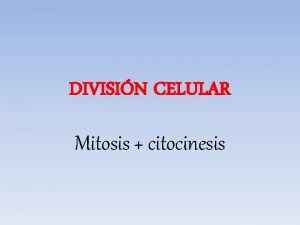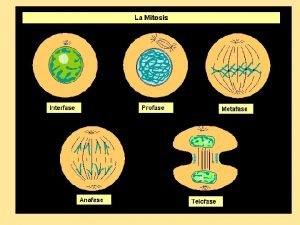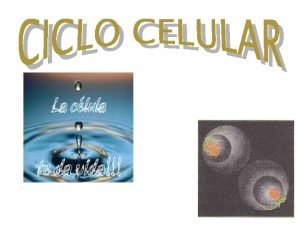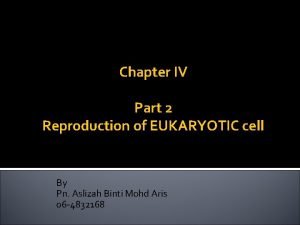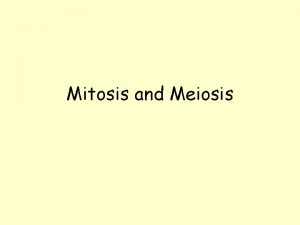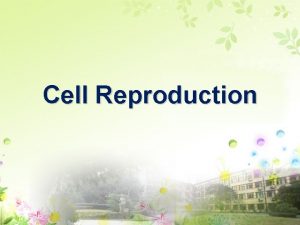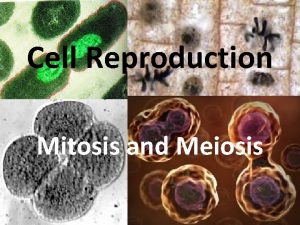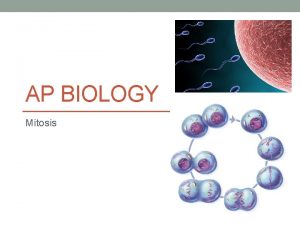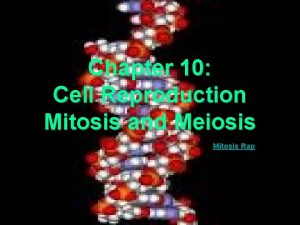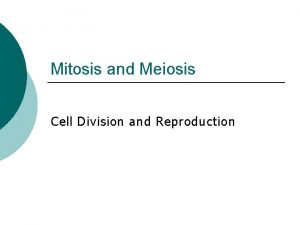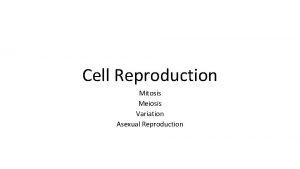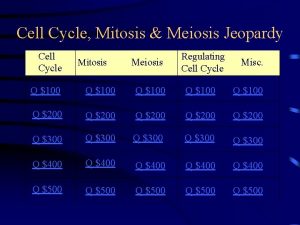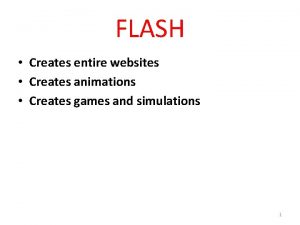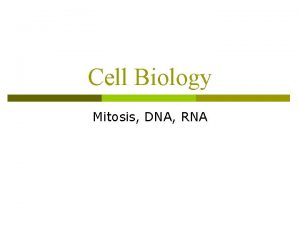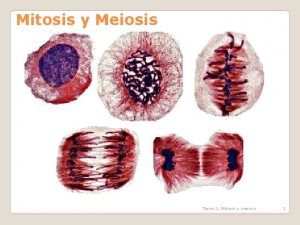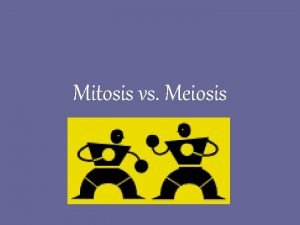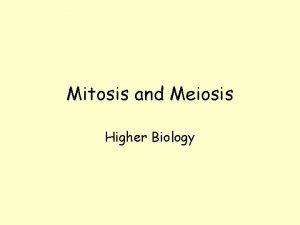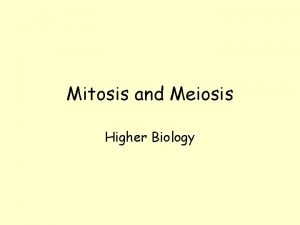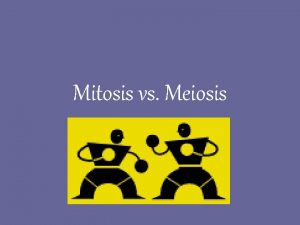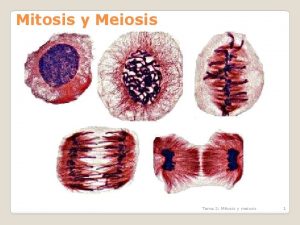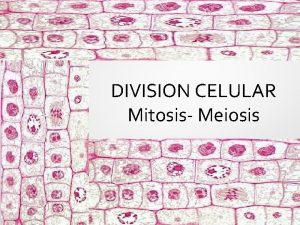1 Cell Reproduction Mitosis Meiosis Creates 2 identical


































- Slides: 34

1

Cell Reproduction Mitosis Meiosis Creates 2 identical cells Creates 4 different cells Creates body cells Creates sex cells Diploid cells = 2 n or 2 sets of chromosomes Haploid cells = 1 n or 1 set of chromosomes Body cells, Skin Cells, Tissues, Organs Sperm and egg 2

Increase in number of cells. ____________________ Replace worn out or damaged cells. 3

4

THE CELL CYCLE HAS FOUR MAIN EVENTS. � 1. Gap 1: Cell Growth � 2. Synthesis: DNA Replication � 3. Gap 2: Preparation of Mitosis � 4. Mitosis Interphase – A long period of cell growth 5

G 1 Phase: The cell grows in size. Doubles organelles. Checkpoint 1 S Phase: DNA # is Checkpoint 2 doubled. G 2 Phase: Finishes growth and gets ready *Has 2 complete sets of DNA for mitosis. Cell cycle animation 6

G 1 phase: Cell Growth S phase: DNA Replication 7

1 Chromosome = 1 chromatid Duplicated Chromosome = Sister chromatids 8

Chromatid centromere Holds the duplicated chromosome together Condensed, duplicated chromosome or sister chromatids • G 2 phase: Cell gets ready for mitosis 9

INTERPHASE Centrioles copies are made ***DNA is in the form of Chromatin (ball of DNA) 1. More cytoplasm- cell grows. 2. DNA is being replicated. 3. More organelles The cell is getting ready for MITOSIS, cell division. 10


MITOSIS – PROPHASE Fibers form Centrioles move apart. X X Chromatin forms visible chromosomes Nuclear Membrane Breaks down 12

1. DNA Chromatin condenses into visible chromosomes 2. Nuclear 3. Centrioles Membrane Begins to break down Move apart from one another in opposite directions 4. Fibers Form between centrioles 13

MITOSIS – METAPHASE Spindle fibers connect to the centerioles THE NUCLEAR MEMBRANE IS NO LONGER PRESENT X X Sister chromatids are lined up along the middle of the cell connecting to the fibers. Centrioles move to opposite poles. 14

1. Centrioles 2. Fibers Continue to move to opposite ends of the cell Attach to the sister chromatids. 3. DNA Sister chromatids are pulled to the middle of the cell 4. Nuclear Membrane Is completely gone 15

MITOSIS – ANAPHASE > > Centrioles are at opposite poles. > > Sister Chromatids separate as the fibers pull them apart Fibers begin to shorten and will start pulling the sister chromatids apart THE NUCLEAR MEMBRANE IS STILL MISSING 16

1. Sister Chromatids 2. Fibers Pulled apart Pull each chromatid toward opposite ends of cell Each chromatid is separate from its “sister” 3. Centrioles 4. Nuclear Membrane Still at opposite sides of the cell Is still gone 17

MITOSIS – TELOPHASE > >> > Nuclear Membrane begins to reappear Cell Membrane pinches together near the center Chromosomes are separated and a full set is located at each end of the cell > > >> Centrioles continue to move apart, pulling at the cell’s ends. Fibers continue to shorten and disappear 18

1. Sister 2. Nuclear Chromatids Membrane Each end of cell has a complete set of chromosomes. Begins to reform around the sets of chromosomes 3. Cell Membrane Begins to pinch at the center, forming two new identical cells 4. Fibers Begin to disappear 19

Cell Membrane splits into two new identical cells 20

21

Phases of Mitosis: • Prophase • Metaphase • Anaphase • Telophase 22

Another Animation of Mitosis Cell Cycle of Mitosis Control of the cell cycle Interactive review of mitosis from Classzone. com 23

The process is VERY SIMILAR in each type of cell. There are only 2 differences: 1. Plant cells do not have centrioles 2. The cell membrane cannot pinch because of the cell wall. 3. Instead a cell plate forms between the 2 nuclei division. 24


External factors Physical signal – cell to cell contact. Once a cell touches another cell it stops dividing. When cells fail to respond to the external signal, the cells continue to divide uncontrollably and form clumps. Tumor – is a clump of cancer cells. Benign – tumor is harmless, the cells are clustered together tightly and can be removed. Malignant – tumor is bad, the cells can break away and be carried to other parts of the body. When a tumor has metastasized, it means the cancer cells have spread to other parts of the body. 26

Cancer cells do not perform the specialized functions needed by the body. In the lung – cancer cells do not exchange oxygen and carbon dioxide. In the brain – they do not transmit the messages needed to interpret information to the body Can exert great pressure on surrounding organs. 27

Carcinogen – a substance known to produce or promote the development of cancer cells. 28

normal cell cancer cell bloodstream 29

MEIOSIS (CELL REPRODUCTION) Cuts chromosome number in half. Creates haploid cells. Creates sperm and egg Spermatogenesis – the creation of sperm Oogenesis – the creation of ova (egg) 30

Sperm or Eggs In males: These cells develop into 4 individual sperm that are genetically different from the parent cell. In females: These cells would have developed into 3 small polar bodies which will die and only 1 large egg. (THIS IS DUE TO AN UNEVEN DIVISION OF CYTOPLASM DURING MEIOSIS) 31

Fertilization: Union of sperm and Egg Creates a zygote Re-establishes the full number of chromosomes 2 chromosomes 4 chromosomes 32

For growth and to replace old, worn out cells. Occurs in body cells Two cells from 1 cell Identical cells to the parent cell. Same number of chromosomes as the original (2 N) - diploid One division of the nucleus. • To make sperm and eggs with • Occurs in sex cells • Four cells from 1 cell • Genetically different from the parent cell. • Half the number of chromosomes (1 N) - haploid • Two divisions of the nucleus. 33

34
 Cell division mitosis and meiosis
Cell division mitosis and meiosis Mitosis
Mitosis Mitosis concept map
Mitosis concept map Identical by descent vs identical by state
Identical by descent vs identical by state Venn diagram of sexual and asexual reproduction
Venn diagram of sexual and asexual reproduction Asexualk
Asexualk Sexual and asexual reproduction in animals venn diagram
Sexual and asexual reproduction in animals venn diagram Sexual and asexual reproduction
Sexual and asexual reproduction Section 1 meiosis
Section 1 meiosis Sexual reproduction and genetics section 1 meiosis
Sexual reproduction and genetics section 1 meiosis Meiosis reproduction
Meiosis reproduction Bioflix activity: mitosis -- events of mitosis
Bioflix activity: mitosis -- events of mitosis Write difference between mitosis and meiosis
Write difference between mitosis and meiosis Keslerscience
Keslerscience Somatic cells vs gametes
Somatic cells vs gametes Diferencia entre mitosis y meiosis
Diferencia entre mitosis y meiosis Diferencia entre mitosis y meiosis
Diferencia entre mitosis y meiosis Huso mitotico
Huso mitotico Mitosis and meiosis youtube
Mitosis and meiosis youtube Chromosomes number is maintained mitosis or meiosis
Chromosomes number is maintained mitosis or meiosis Mitosis purpose
Mitosis purpose Diploiid
Diploiid Anaphase
Anaphase Chromosomes number is maintained mitosis or meiosis
Chromosomes number is maintained mitosis or meiosis Metaphase 2
Metaphase 2 Mitosis prophase vs meiosis prophase 1
Mitosis prophase vs meiosis prophase 1 Conclusion of mitosis and meiosis
Conclusion of mitosis and meiosis Cell cycle flip book
Cell cycle flip book Venn diagram of meiosis and mitosis
Venn diagram of meiosis and mitosis Diferencias entre mitosis y meiosis tabla
Diferencias entre mitosis y meiosis tabla Ciclo celular
Ciclo celular Haploide
Haploide Cromosomas hijos
Cromosomas hijos Tabla comparativa entre mitosis y meiosis
Tabla comparativa entre mitosis y meiosis Chromosome sets (=n) in mitosis and meiosis
Chromosome sets (=n) in mitosis and meiosis










